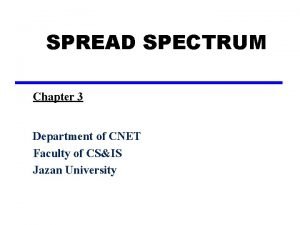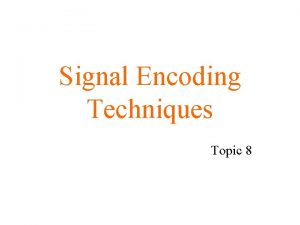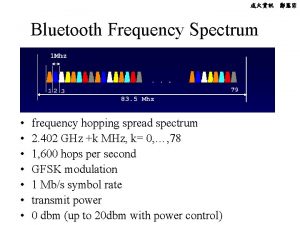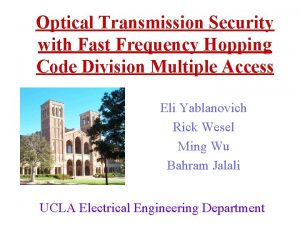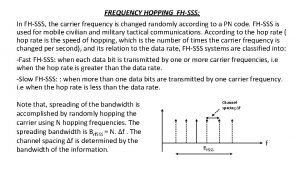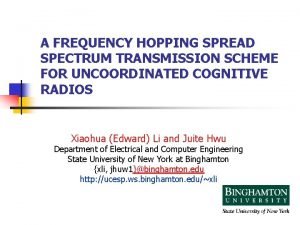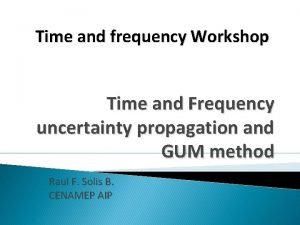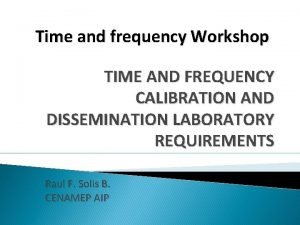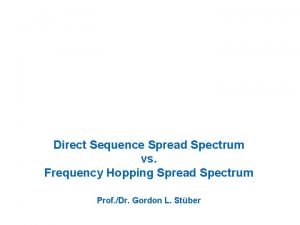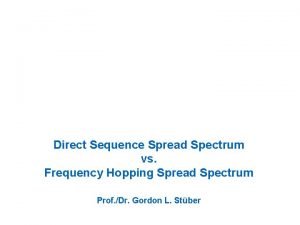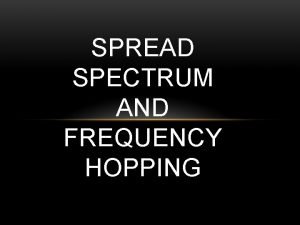Transmission Security via Fast Time Frequency Hopping PI














- Slides: 14

Transmission Security via Fast Time -Frequency Hopping PI: Eli Yablanovich Co-PIs: Rick Wesel Ingrid Verbauwhede Ming Wu Bahram Jalali UCLA Electrical Engineering Department

Four users, each with four bits • • Alice’s Data: Bob’s Data: Carol’s Data: Dave’s Data: A 1, A 2, A 3, A 4 B 1, B 2, B 3, B 4 C 1, C 2, C 3, C 4 D 1, D 2, D 3, D 4

Random Hopping on a Time. Wavelength Grid • A user appears on zero, one, or more wavelengths each symbol. • Users select positions in grid in an unpredictable fashion. Wavelength 1 A 1 D 2 C 1 D 4 Wavelength 2 A 2 C 3 B 1 Wavelength 3 D 1 A 4 D 3 B 2 Wavelength 4 C 4 A 3 B 4 Time

User A 1 A 2 A 3 A 4 B 1 B 2 B 3 B 4 C 1 C 2 C 3 C 4 D 1 D 2 D 3 D 4 Bit Index 16 16 Switch Wavelength Grid-to-Grid Mapping is a Switch A 1 D 2 C 1 D 4 A 2 C 3 B 1 D 1 A 4 D 3 B 2 C 4 A 3 B 4 Time • There are 16! possible configurations of this switch. • The switch configuration may be specified by log 2(16!)=44. 25 bits

16 16 Switch Wavelength 16 Users (A-P) Grid-to-Grid Mapping is a Switch also supports 16 users on 16 wavelengths with wavelength-only hopping at a total rate of 10 Gbps.

A Pipelined Switch Code bit = 0 Code bit = 1 • There are 16! possible configurations (44. 25 bits). • There are 56 switches, but four can be fixed so that 52 bits specify the configuration. • Thinking about future feasibility, for a 100 switch, not all switch positions need to be randomized.

Four Switches Taking Turns 155 MHz 2. 5 Gbps 16 X 16 Switch 1: 16 User 1 2. 5 Gbps 16: 1 Modulator Each 16 X 16 switch (the blue box) l 1 16 X 16 Switch 1: 16 User 2 16: 1 Modulator runs at 155 MHz, l 2 16 X 16 Switch 1: 16 User 3 4: 1 16: 1 Modulator l 3 16 X 16 Switch 1: 16 User 4 16: 1 Modulator l 4 Pat. Gen 1: 16 de-Serializer 16: 1 Serializer which is ¼ times 1/16 times 10 GHz.

User A 1 A 2 A 3 A 4 B 1 B 2 B 3 B 4 C 1 C 2 C 3 C 4 D 1 D 2 D 3 D 4 Bit Index 16 16 Switch Wavelength The Big Picture A 1 D 2 C 1 D 4 A 2 C 3 B 1 D 1 A 4 D 3 B 2 C 4 A 3 B 4 Time We need 52 bits or 9 Gbits/sec (We can do about 20 Gbits/sec) Advanced Encryption Standard Random bit generator (initially just a linear feedback shift register)

What Kinds of Security Are Possible? • Security by Obscurity – This is no security at all. Obscurity is fleeting. • Security by computational difficulty – Standardized systems like DES and AES rely on this. – Must consider attacks where plain-text is known. • The one-time pad that nobody else knows – Perfect as long as the pad remains secret.

Hopping versus Spreading • Our technique focuses on the addition of cryptographic security in the context of relatively straightforward frequency-hopped CDMA. • Certainly, similar techniques could be applied to the other OCDMA techniques described during this meeting. • However, in every case, the real security comes from (high speed) cryptographic security rather than obscure optical techniques.

Network Security • Most sophisticated security techniques add security at the source only (application layer). • Our technique adds security at the physical layer (or at the network layer).

Why Have Network Security? • Increase the difficulty of attack, even with plaintext available. (The ciphertext of an individual stream is now difficult to identify. ) • Adds security with minimal latency (the latency inherent in the timespan of the permutation) because AES processing is not in the real-time path. .

Synchronous vs. Asynchronous • Our original vision was for with synchronous operation (and a universally known key) as a requirement. • However, our system concept can trade spectral efficiency to operate asynchronously. • Example: Sixty wavelengths but still using only sixteen of the two hundred forty available slots, each transmitter can have it’s own key. • Collisions lead to a bit error rate of. 1%. • Reed Solomon error correction brings FER to well below 10 -10.

Effect of Error Control
 Frequency hopping spread spectrum
Frequency hopping spread spectrum Frequency-hopping spread spectrum
Frequency-hopping spread spectrum Bluetooth frequency hopping
Bluetooth frequency hopping Private security
Private security Acid fast vs non acid fast
Acid fast vs non acid fast Acid fast and non acid fast bacteria
Acid fast and non acid fast bacteria Decimoquinta estacion via crucis
Decimoquinta estacion via crucis La via negativa
La via negativa 14 estaciones vía lucis estaciones
14 estaciones vía lucis estaciones Via piramidal y extrapiramidal
Via piramidal y extrapiramidal Via erudita e via popular
Via erudita e via popular Kangaroos hopping down mountains
Kangaroos hopping down mountains Leapfrogging island hopping
Leapfrogging island hopping Island hopping
Island hopping Who was the mastermind of the island-hopping strategy
Who was the mastermind of the island-hopping strategy
